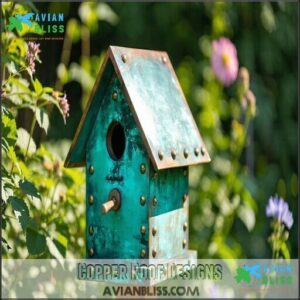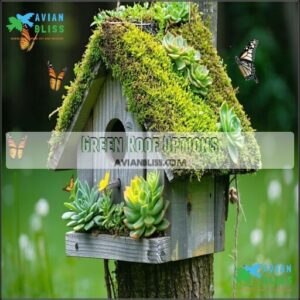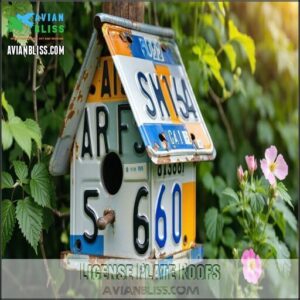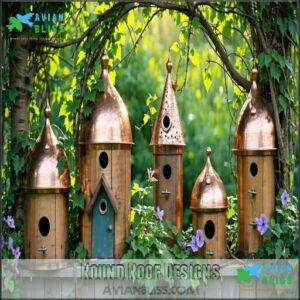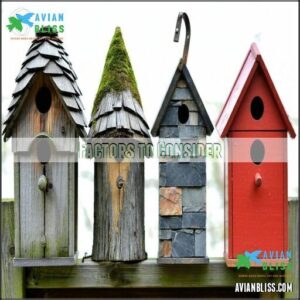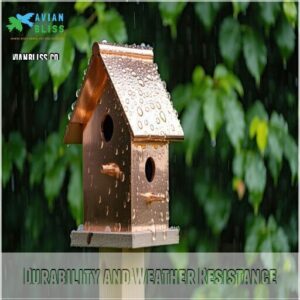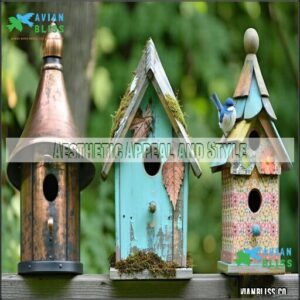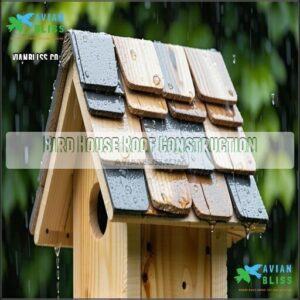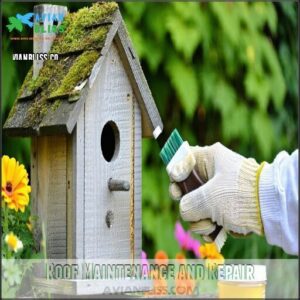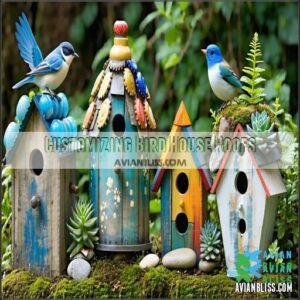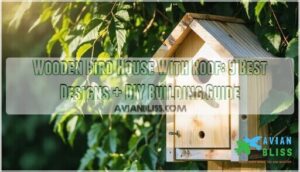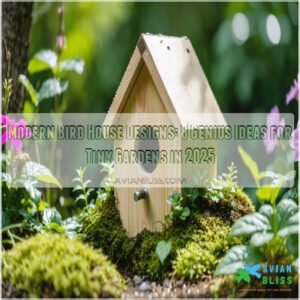This site is supported by our readers. We may earn a commission, at no cost to you, if you purchase through links.
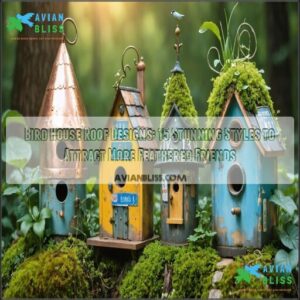 In the context of bird house roof designs, you’ve got options as colorful as the birds you’re attracting!
In the context of bird house roof designs, you’ve got options as colorful as the birds you’re attracting!
A copper roof adds charm and durability, handling weather like a pro.
Green roofs, planted with moss or sedum, offer insulation and blend beautifully with nature.
For something quirky, try license plate roofs—recycled, rustic, and eye-catching.
Prefer a classic aesthetic?
A round, domed roof lets rain slide right off.
Whatever design you choose, make sure it’s weatherproof, sloped for drainage, and securely attached.
After all, every feathered tenant deserves a cozy, safe haven.
Curious how to personalize your design?
The possibilities are endless!
Table Of Contents
- Key Takeaways
- Bird House Roof Types
- Roof Material Selection
- Bird House Roof Construction
- Roof Maintenance and Repair
- Customizing Bird House Roofs
- Frequently Asked Questions (FAQs)
- What are easy DIY Birdhouse roof ideas?
- Does a birdhouse need a roof?
- Can you build a birdhouse on your own?
- How do you attach a roof to a birdhouse?
- How to design a birdhouse?
- How do you secure the roof of a birdhouse?
- What to use for a bird house roof?
- What is the angle of a birdhouse roof?
- What not to do when building a birdhouse?
- Can you build a birdhouse on a roof?
- Conclusion
Key Takeaways
- Choose durable materials like cedar or copper to ensure your birdhouse lasts through harsh weather.
- Add a sloped roof for proper drainage and overhangs to protect the inside from rain and moisture.
- Go green with a living roof using moss or succulents to provide insulation and attract wildlife.
- Personalize your birdhouse with recycled materials or painted designs to make it both functional and unique.
Bird House Roof Types
You’ll find that the roof of your birdhouse substantially affects both its functionality and appeal to various bird species.
From copper and green living roofs to recycled license plates and classic rounded designs, each roof type offers specific benefits for weather protection and creates a distinctive aesthetic for your feathered visitors.
Copper Roof Designs
Copper roof designs stand out as the crown jewel of bird house toppers.
The copper roof truly reigns as the ultimate gem, blending timeless elegance with unmatched durability for your feathered friends’ sanctuary.
You’ll appreciate how copper sheets transform ordinary structures into elegant homes that weather beautifully over time.
With proper installation techniques, copper develops a stunning green-blue patina that actually protects the material.
Though initially pricier than other materials, copper’s 40+ year lifespan makes it cost-effective in the long run.
Shaping techniques range from simple flat designs to complex riveted patterns.
Green Roof Options
While copper adds elegance, living green roofs bring nature directly to your birdhouse.
Living green roofs transform birdhouses into vibrant ecosystems, blending natural beauty with functional habitats for birds and beneficial wildlife.
These plant-covered tops aren’t just beautiful—they’re functional ecosystems that support wildlife right in your backyard.
Green roof options offer:
- Natural insulation that keeps interiors cool during summer heat
- Moisture retention that creates a comfortable microclimate for nesting
- Habitat support that attracts butterflies and beneficial insects alongside birds
Choose low-water sedum plants for weight considerations and minimal irrigation needs.
Some birdhouses utilize reclaimed wood materials for a rustic aesthetic.
Your feathered friends will appreciate this living habitat that transforms a simple shelter into a biodiversity hotspot with natural insulation and moisture retention.
License Plate Roofs
Looking to transform old license plates into charming birdhouse roofs? These recycled treasures offer both durability and character.
When sourcing plates, look for weathered designs with personality. Simple cutting techniques and proper attachment methods guarantee your feathered friends enjoy a waterproof shelter that stands out in your garden.
Round Roof Designs
While license plates add character, round roof designs bring elegance and practicality to your bird house.
These curved structures create a distinctive silhouette in your garden while providing excellent protection.
- Dome construction shelters nesting birds from harsh downpours
- Conical roof styles prevent debris accumulation and improve drainage
- Spherical roof drainage systems keep interior nests dry
- Circular roof materials like copper sheets weather beautifully over time
Curved roof framing isn’t just for show—birds actually prefer these smooth, protective shapes that mimic natural nesting cavities. They provide a practical and protective environment for the birds.
Roof Material Selection
You’ll need to select the right materials for your birdhouse roof to guarantee both protection and appeal for your feathered visitors.
Cedar, copper, and treated pine offer excellent durability against weather elements, while their natural textures create an attractive habitat that birds will flock to.
Factors to Consider
When selecting roof materials for your bird house, climate impact should top your priority list.
Different bird species have specific shelter needs—some prefer cooler roofs, while others need extra insulation.
Consider material weight too; heavier options might require stronger support structures.
Your cost analysis should balance quality and budget, while functionality must address weather patterns in your area.
Remember that durability and aesthetic appeal can coexist.
The right roof material creates a home that’s both practical for birds and pleasing to your eye.
Durability and Weather Resistance
Beyond design appeal, your birdhouse roof needs to withstand Mother Nature’s moods.
For maximum material lifespan, consider how local climate impacts your choices. Vinyl roofs won’t rot or crack, while copper delivers exceptional durability with its natural weather resistance.
Proper structural integrity prevents leaks and guarantees water runoff flows correctly. When designing for the long haul, choose waterproof options that also offer pest resistance, protecting your feathered visitors from unwanted guests.
Aesthetic Appeal and Style
Creating your birdhouse roof’s aesthetic appeal involves more than just functionality—it’s a chance to express style.
Mix textures, shapes, and color palettes that complement your garden setting. Decorative trim and roof ornamentation turn simple shelters into mini architectural wonders, while themed designs showcase your personality.
Visual harmony comes from balancing bold and subtle elements. Whether you choose copper’s rich patina or weathered wood’s rustic charm, your decorative roof choices can enhance your home’s curb appeal while still attracting feathered visitors.
Bird House Roof Construction
You’ll need to align your roof panels carefully with the birdhouse structure and create a slight overhang to protect the walls from moisture.
Weather-resistant screws, proper drainage holes, and attention to material selection will guarantee your birdhouse roof withstands the elements while providing a safe haven for your feathered visitors.
Step-by-Step Installation
With your materials ready, it’s time to transform your birdhouse roof from concept to reality!
Start installing your roof with precision and care:
- Apply wood glue along the top edges of front and back walls
- Position both roof panels so they meet perfectly at the peak
- Drill pilot holes before nailing to prevent wood splitting
- Verify equal overhang on both sides for proper water runoff
- Wipe away excess glue for a clean, professional finish
For angled cuts, set your saw to 31 degrees for the perfect pitch.
Remember to measure twice before making any cuts—your roof’s panel alignment makes all the difference in protecting your feathered tenants from rain and wind! **Consider using untreated cedar for moisture resistance.
Essential Tools and Materials
The right toolkit makes all the difference when crafting your birdhouse roof.
Gather these essential materials and tools before you begin:
| Category | Basic Needs | Premium Options |
|---|---|---|
| Tools | Measuring tape, handsaw | Electric drill, tin snips |
| Materials | Pine (1/2" thickness) | Cedar, copper sheets |
| Fasteners | Galvanized wood screws | Stainless steel nails |
| Safety | Work gloves | Protective glasses |
For a lasting roof, consider using durable roofing materials to ensure durable construction.
Store wood in a dry place to prevent warping before construction begins, and always use proper safety equipment.
Safety Precautions and Tips
While gathering tools for construction, don’t forget the equally important safety measures for your bird house roof project.
Protect yourself with these basics:
- Always wear safety glasses and gloves when cutting materials for your waterproof roof
- Keep a stable ladder on level ground when installing roof overhangs
- Use proper ventilation when applying sealants to create a durable roof
Handle materials carefully to prevent splintering, and remember that sharp roof edges can harm both you and visiting birds. Small precautions prevent big accidents!
Roof Maintenance and Repair
You’ll need to inspect your birdhouse roof twice yearly for damage and remove debris that can trap moisture and cause rot.
Regular maintenance will extend your roof’s lifespan and guarantee your feathered residents stay comfortable and protected through changing seasons, which is crucial for their well-being and regular maintenance.
Cleaning and Inspection
Bird enthusiasts should make roof inspection a seasonal ritual. Schedule thorough cleanings twice yearly—early spring and late fall—using a soft brush and mild soap solution.
During these inspections, check for structural integrity issues, mildew, and pest infestations that might compromise your birdhouse. Always wear gloves when cleaning and verify the roof dries completely to prevent moisture damage.
Regular maintenance prevents small problems from becoming major repairs and keeps your feathered residents safe and comfortable. For thorough roof maintenance and repair, follow established bird house cleaning tips to ensure a safe environment.
Repairing Damaged Roofs
Weather, pests, and wear can harm your birdhouse roof, but thoughtful repairs restore its charm and strength.
Start by disassembling the roof to inspect for structural damage. Replace damaged sections with weather-resistant materials to avoid future material degradation. Use wood glue and screws for joint reinforcement. Sand and seal the wood to enhance durability.
For specialized needs, consider exploring options for birdhouse roof components.
Here’s how to start:
- Patch holes with water-safe materials
- Replace rusted hardware
- Strengthen corners with glue
- Inspect for leaks
- Securely reattach pieces
Preventing Water Damage
Fixing roof damage isn’t enough—you’ve got to keep water out for good.
Start with drainage solutions like placing holes in the base to avoid pooling. Use waterproof materials, like cedar or copper, to enhance weather resistance.
Add a 2-inch overhang design to shed rain, while sealing joints with exterior-grade caulk.
Cedar birdhouses, known for their natural resistance to rot, can last for years with proper care.
Combine these tips to master preventing water damage!
Customizing Bird House Roofs
You can transform a plain birdhouse roof into a functional and eye-catching masterpiece with just a few creative touches.
From adding recycled materials to painting vibrant patterns, customizing your roof helps attract birds while showcasing your personal style, and this can be a great way to add a personal touch to your birdhouse.
Unique Design Ideas
Make your birdhouse unforgettable with themed aesthetics and functional roofs.
Think living roofs that boast lush moss or quirky custom designs crafted from recycled materials like old license plates. Add aesthetic harmony with unique roof shapes, such as curved or tiered styles.
These bird house roof designs aren’t just homes—they’re statements that protect birds while impressing the neighborhood.
- Try these ideas:
- Curved or cone-shaped roofs for flair.
- Living roofs with natural moss.
- Vintage license plates for a retro vibe.
- Predator guards cleverly integrated into the design.
Adding Decorative Elements
Jazz up your birdhouse roof with creative touches that captivate both birds and people.
Try adding Roof Peak Decor like a wooden ball, or use Painted Roofs with nature-inspired patterns.
Add character with Weathered Wood Stain for a rustic vibe or etched designs for subtle elegance.
Living Roof Moss offers natural charm, while themed birdhouse roof elements add a personal flair.
Consider the birdhouse materials and safety when selecting your roofing elements.
These Custom Birdhouse Elements turn functional designs into unique rooftop masterpieces.
Incorporating Recycled Materials
Turn discarded treasures into charming birdhouse roof designs.
Recycled materials like license plates or flattened aluminum cans add quirky style while cutting costs.
Creative material sourcing offers design versatility—think colorful tin tiles or wood scraps.
Consider using pre-made recycled roofs for convenience.
Boost your birdhouse’s environmental impact by repurposing scraps responsibly, making certain they’re safe and durable.
Proper material preparation guarantees long-lasting charm that’s both functional and eco-friendly, ensuring your birdhouse has a positive design versatility.
Frequently Asked Questions (FAQs)
What are easy DIY Birdhouse roof ideas?
Use cedar shakes for a rustic vibe, license plates for quirky charm, or moss for an eco-friendly touch.
A smooth copper roof adds elegance, while painted wooden panels let you match your yard’s personality.
Does a birdhouse need a roof?
Yes, a birdhouse absolutely needs a roof.
It shields birds from rain, sun, and predators.
Without one, nests could get soaked or overheated, making the birdhouse less cozy and safe for its feathered visitors.
Can you build a birdhouse on your own?
Did you know nearly 80% of bird species will use a well-designed birdhouse?
Building one yourself is simple!
Grab some wood, a saw, and drill, then customize it to attract charming feathered guests.
How do you attach a roof to a birdhouse?
Align the roof panels with the birdhouse, securing them with weatherproof screws or nails at the edges.
Add a slight overhang for rain protection.
Check for alignment and stability before tightening everything securely.
How to design a birdhouse?
Start with sturdy, weather-resistant wood like cedar, cutting pieces to fit snugly.
Add ventilation holes, a sloped roof for drainage, and overhangs for protection.
Customize it with paint or plants to attract birds and beautify.
How do you secure the roof of a birdhouse?
Secure a birdhouse roof by using weather-resistant screws or nails, ensuring precise alignment with slight overhangs.
Add drainage holes to prevent pooling.
Tighten connections but don’t overdo it—birds prefer stability, not a fortress!
What to use for a bird house roof?
Pick durable materials like cedar, copper, or recycled metal for a birdhouse roof.
They resist weather, last long, and look great.
Add a slight slope or overhang for rain protection and proper drainage to prevent damage, using durable materials.
What is the angle of a birdhouse roof?
A 15-20 degree angle works best for a birdhouse roof.
It lets rain roll off smoothly, preventing pooling and damage.
Plus, it adds just enough slope for a durable, weather-resistant roof without overcomplicating construction, making it a weather-resistant choice.
What not to do when building a birdhouse?
Fun fact: 56% of birdhouses fail due to poor design.
Don’t skip ventilation holes, use toxic paint, or pick overly bright colors.
Avoid small openings—they trap heat.
Always plan for predators and weatherproofing!
Can you build a birdhouse on a roof?
Yes, you can build a birdhouse on a roof, but choose a shady spot, make certain it’s stable, and avoid areas prone to extreme heat or wind.
Birds need safety, comfort, and easy entry access.
Conclusion
Just like a well-placed perch, the right bird house roof design can make all the difference.
Whether you’re drawn to the elegance of copper, the eco-friendliness of green roofs, or the whimsy of license plates, every choice shapes a welcoming sanctuary.
Focus on durability, weatherproofing, and proper slope to keep your feathered guests happy.
With these tips, your bird house roof designs will attract birds as well as enhance your outdoor space with charm and purpose.
- https://www.thebirdhousechick.com/collections/copper-roof-birdhouses?srsltid=AfmBOoq8SmtAaKGFrZ1atfOn8y1QHUuJ3nmUzc45BnZDOa7FMeZKisTf
- https://www.ncbirdguy.com/birdhouses-feeders.php
- https://www.pinterest.com/meridaangelina/birdhouse/
- https://www.youtube.com/watch?v=au0bzfZtHH4
- https://www.woodworkingtalk.com/threads/birdhouse-roof.216583/

